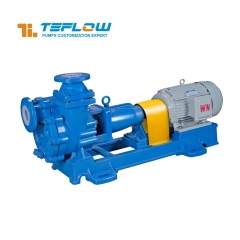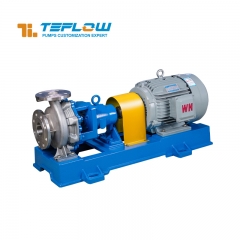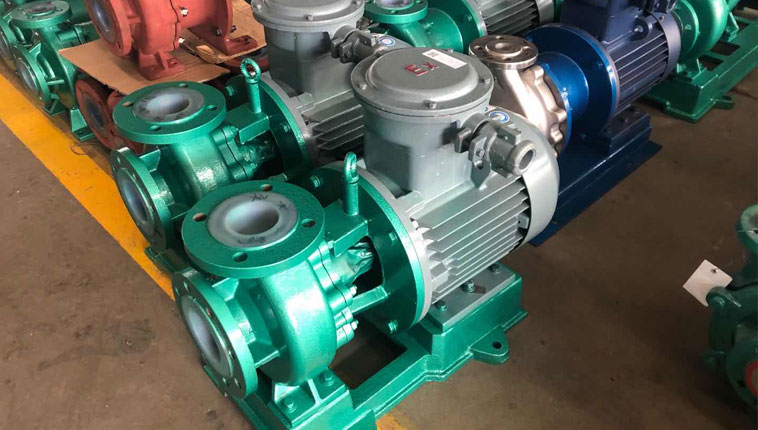Acid and alkali resistant self-priming pumps are key equipment for transporting corrosive media in the chemical, electroplating, environmental protection and other industries. Their suction stability directly affects production efficiency. If the suction becomes weaker, it is necessary to investigate from multiple dimensions such as equipment structure, medium characteristics, operation and maintenance.
1. The sealing performance of the pump body is reduced
Seal failure is a common cause of suction loss. The seals of acid and alkali resistant self-priming pumps (such as mechanical seals and O-rings) are exposed to corrosive media for a long time and are prone to aging, deformation or wear, which causes the inner cavity of the pump body to communicate with the outside world and destroy the vacuum environment. For example, scratches on the dynamic and static end faces of the mechanical seal due to corrosion can allow air to infiltrate, causing "air binding"—the air in the pump cannot be completely exhausted, preventing the formation of an effective negative pressure, thereby reducing suction. In addition, loose connecting bolts between the pump cover and the pump body and damaged sealing gaskets can also lead to poor sealing and affect suction.
2. Impeller failure or blockage
The impeller is the core component that generates suction in a self-priming pump, and its condition directly determines the suction. On the one hand, corrosive media can erode the impeller, causing blade wear, perforation, or surface scaling, disrupting the impeller's streamlined structure and reducing liquid delivery efficiency. On the other hand, impurities in the media (such as solid particles and crystals) can easily clog the impeller flow path, hindering liquid flow and reducing the pump's actual displacement, manifesting as reduced suction. If the medium has a high solid content and no filtration device is installed, the impeller clogging problem will be more frequent.
3. Suction line problem
The patency and sealing of the pipeline have a significant impact on suction. First, pipeline blockage is a common problem: impurities in the medium may accumulate on the inner wall of the suction pipe, or the pipeline valve may not be fully opened, resulting in a reduced flow area and increased liquid delivery resistance. Secondly, air leakage in the suction pipeline will introduce air, which is similar to a failure of the pump body seal, destroying the vacuum and weakening the suction. Common leaks include loose pipe joints, aging flange sealing gaskets, and damaged suction pipes. In addition, if the suction pipeline is too long, the pipe diameter is too small, or the suction height exceeds the rated self-priming height of the pump (usually 3-5 meters), it will increase the resistance to liquid flow and lead to insufficient suction.
4. Changes in conveying medium characteristics
The design of acid and alkali resistant self-priming pumps is based on specific medium parameters. If the medium characteristics change, the suction force may decrease. First, the viscosity of the medium increases. For example, the viscosity of some chemical slurries increases when the temperature drops, the liquid fluidity deteriorates, and the pump's delivery capacity weakens. Second, the gas content of the medium increases. When the gas dissolved in the medium escapes or the air is mixed into the suction pipeline, a gas-liquid mixture is formed, which reduces the liquid density in the pump, resulting in insufficient centrifugal force generated by the impeller and reduced suction. Third, the corrosiveness of the medium increases, accelerating the corrosion and wear of the flow-through components in the pump (such as the impeller and pump casing), and damaging the original performance of the equipment.
5. Motor or transmission system failure
As the power source, abnormal operation of the motor will indirectly lead to reduced suction. If the motor voltage is too low, the output power will drop, the speed will decrease, the impeller rotation speed will slow down, and the kinetic energy obtained by the liquid will be insufficient; single-phase operation of the motor or burning of the winding will cause abnormal speed or shutdown; in addition, the coupling between the motor and the pump body is loose, and the coaxiality deviation is too large, which will cause the transmission efficiency to drop, affect the normal operation of the impeller, and ultimately manifest as suction attenuation.
A decrease in suction power in acid- and alkali-resistant self-priming pumps is the result of multiple factors, requiring a comprehensive investigation based on the equipment's operating status, media parameters, and maintenance records. During daily use, regularly inspecting seals, cleaning pipeline impurities, monitoring media characteristics, and maintaining the motor system can effectively prevent suction loss and ensure stable equipment operation.





 +86 18130251359
+86 18130251359 teflowpumps@tlpumps.com
teflowpumps@tlpumps.com











 +86+0563-5093318
+86+0563-5093318
